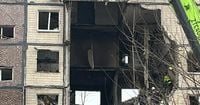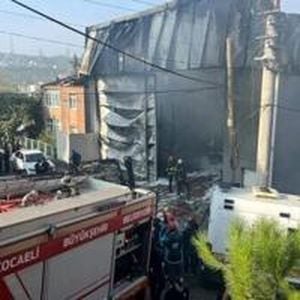In the predawn hours of November 8, 2025, the city of Dnipro—Ukraine’s fourth-largest metropolis—was shaken awake by an explosion that would leave a scar not just on its skyline, but on the nation’s already battered spirit. A Russian drone, part of what Ukrainian authorities described as Moscow’s “largest-ever attack,” slammed into a nine-story residential tower, killing three civilians and injuring 12 more, including two children—one just two years old, according to reports from Reuters and France 24.
Images from the aftermath show a gaping hole torn into the building’s façade, several apartments reduced to rubble, and firefighters scrambling to douse flames as emergency crews pulled survivors from the wreckage. The attack, which occurred while most residents were sleeping, was just one piece of a coordinated Russian barrage that swept across Ukraine, targeting not only homes but also the country’s vital energy infrastructure.
Ukraine’s state-owned power company, Centrenergo, reported that all its plants were forced offline in the wake of the assault. "Less than a month has passed since the previous strike, and last night the enemy again hit all of our power generation facilities simultaneously," the company posted on Telegram. Drones struck power plants in Kyiv, Kharkiv, and Donetsk “each minute” overnight, leading to widespread outages and leaving Kyiv residents without electricity for up to 12 hours at a stretch as emergency power cuts were rolled out.
The scale of the onslaught was staggering. According to Ukrainian authorities and confirmed by France 24, Russia launched a total of 458 drones and 45 missiles, including 32 ballistic missiles, during the attack. Ukrainian forces managed to shoot down 406 drones and nine missiles, but the sheer volume meant that devastation was inevitable. In addition to the tragedy in Dnipro, a worker at an energy company in Kharkiv was killed, and power was switched off in several regions to prevent further damage and casualties.
Ukrainian President Volodymyr Zelensky did not mince words in his response, calling the strike “very flagrant and demonstrative.” In a video address on X, he stated, "The main targets of this strike were our cities, our energy sector and our people." The sentiment was echoed by Prime Minister Yulia Svyrydenko, who said on social media, "We are working to eliminate the consequences of the attacks across the country. The focus is on the rapid restoration of heating, electricity and water supply."
For civilians, the toll was immediate and harsh. In Dnipro, the force of the explosion destroyed several apartments and set off a fire that raged through the building. Rescue teams worked through the night, evacuating dozens of residents and treating the wounded—among them, two young children. "Fire and rescue teams helped get dozens of civilians, including two injured children, to safety," reported local emergency services, as cited by Radio Free Europe.
Dnipro was not the only city to suffer. In Kharkiv, Ukraine’s second-largest city, a worker at an energy company lost his life when a facility was struck. The attacks also damaged major energy infrastructure in Kyiv and the central Poltava region, disrupting basic services for thousands. Ukrainian Energy Minister Svitlana Grynchuk confirmed on Facebook that emergency shutdowns were necessary to stabilize the grid and prevent further loss of life.
But the violence was not confined to Ukrainian soil. In the southern Volgograd region of Russia, Governor Andrei Bocharov reported that Russian forces had repelled a “massive” nighttime strike on energy facilities, just two days after Kyiv claimed to have hit a key oil refinery there with long-range drones. The strike knocked out power in parts of the region’s northwest, though no casualties were reported. Meanwhile, in Russia’s Saratov region, two people were injured after a Ukrainian drone strike blew out windows in an apartment block, according to regional Governor Roman Busarin.
These cross-border attacks are part of a broader pattern of tit-for-tat strikes on energy infrastructure. The Kremlin maintains that its targets are strictly related to Kyiv’s war effort, but Ukrainian officials see a different motive: an attempt to “weaponise winter,” as they put it, by crippling the power grid and denying civilians access to heat, light, and running water as temperatures plunge.
The military situation on the ground remains fluid and fiercely contested. In eastern Ukraine, the battle for the strategic city of Pokrovsk has reached a critical juncture. Russian troops have advanced 24 miles into the city after more than a year of fighting, forcing Ukraine to deploy elite units and resulting in intense street-to-street combat that has claimed thousands of soldiers’ lives, according to the Associated Press. Both Kyiv and Moscow are keenly aware of Pokrovsk’s significance—not just as a military prize, but as a bargaining chip in peace negotiations and a means to demonstrate strength to international observers, including U.S. President Donald Trump.
Pokrovsk sits along what analysts have dubbed the “fortress belt” of Donetsk, a line of heavily fortified cities crucial to Ukraine’s defense of the eastern region. The Russian Defence Ministry claimed on November 8 that its forces had encircled Pokrovsk and the nearby town of Myrnohrad, as well as surrounding Ukrainian defenders in Kupiansk, a key railway hub in the Kharkiv region. Ukrainian officials, however, denied that any blockades were in place, insisting that fighting continued and the situation, though dire, was not yet lost.
At the heart of these battles lies a high-stakes political struggle. Russian President Vladimir Putin has made clear that as a prerequisite for peace, Ukraine must cede the Donbas region, which comprises Donetsk—where Russia now controls 72% of the territory—and neighboring Luhansk, which is 99% under Russian occupation. For Kyiv, relinquishing these regions is unthinkable; for Moscow, it is non-negotiable.
The broader context is equally grim. Nearly four years into Russia’s full-scale invasion, drone and missile attacks have become a near-daily occurrence, killing and injuring civilians and leaving Ukraine’s infrastructure in tatters. As U.S.-led diplomatic efforts struggle to make headway, both sides appear determined to prove their resolve on the battlefield, hoping to sway international opinion and ultimately the terms of any future settlement.
For the people of Dnipro and cities like it, the war’s realities are not measured in territorial gains or diplomatic communiqués, but in the sudden loss of a neighbor, the shattering of a home, and the long, cold nights spent without power. As Ukraine races to repair its battered grid and restore basic services, the resilience of its citizens is once again being tested—one more time, in a conflict that shows no sign of abating.




